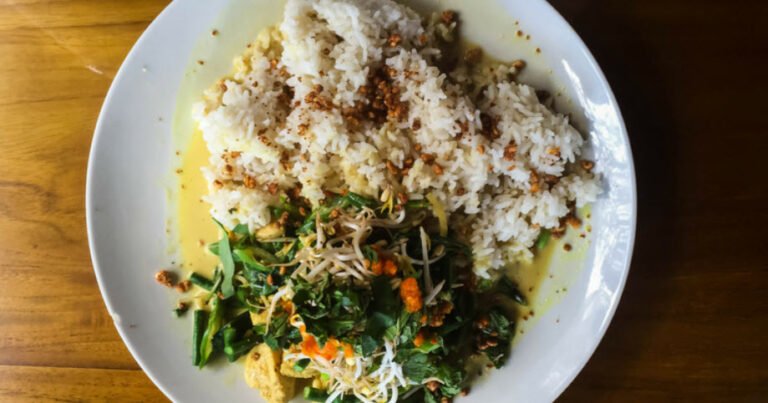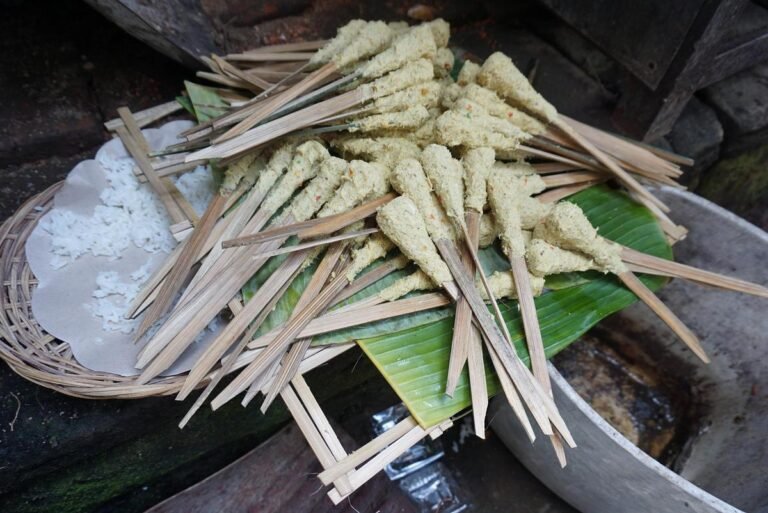Pandan-Wrapped Kue Gambir From Tulikup Brings Fresh Flavor to Bali’s Mochi Tradition
Indonesia’s archipelago hosts a rich variety of traditional treats that reflect each region’s heritage and customs. Among these, kue gambir stands out as an underappreciated snack with an intriguing history and distinctive taste. Villagers call it Jaja Iku-iku, a term that hints at the cake’s gentle jiggle. Often likened to Japanese mochi, this soft cake features a springy center and a wrapping of bright green pandan leaf. The leaf’s fragrant oils infuse the rice dough with a gentle floral note that leaves a lasting impression on the palate.
Local historians trace kue gambir’s roots to Tulikup village in Gianyar Regency on Bali’s southeastern side. That community has long earned a reputation as a hub for age-old cooking practices passed down in families. Craftspeople in Tulikup take pride in turning simple ingredients into edible artworks. The technique of folding the pandan leaf around the dough is taught to each new generation, preserving a method that results in both neat presentation and a hint of green color at every picnic or ceremony. That neat packaging technique not only looks attractive but also helps seal in moisture, preserving the cake’s softness until it reaches the buyer.
Throughout much of the last century, kue gambir production supplied steady work alongside rice farming, market trade and red brick making in Tulikup. Families often gathered at communal kitchen tables before dawn to prepare dozens of cakes for sale at regional markets. Over recent decades, younger residents have sought city jobs, and the number of home-based producers has dropped. Today, village elders and cultural committees collaborate to shine a spotlight on kue gambir and encourage new artisans to learn every step of this shared craft.
The main component of each kue gambir piece is glutinous rice flour, the same base found in Japanese mochi, which gives the cake its signature chew. For the filling, local peanuts are roasted and ground to a powder before mixing with melted palm sugar boiled to a silky consistency. That duo yields a sweet-and-salty taste, intensified by a slight crunch from the nut bits. A pinch of salt balances the sweetness, creating a bite that appeals to those who enjoy both dessert and snack flavors.
Making kue gambir calls for patience and a careful hand. Rice flour dough gets steamed in bamboo baskets or metal steamers until glossy and soft. When still warm, artisans flatten each portion, spoon in the peanut-and-sugar filling and fold the edges to seal. Skilled fingers then wrap each parcel in a fresh pandan leaf strip, tucking in the ends and binding with thin raffia thread. A final steaming session fuses all elements, allowing the leaf’s aroma to soak into the dough and sweet filling.
This cake-making ritual goes beyond food preparation; it brings families together. Grandparents, parents and children often sit in circles to share tasks: one group steams the dough, another rolls out each ball, as youngsters tie the wrappers. In this way, kue gambir serves as a symbol of cooperation and respect for the knowledge elders hold. Offering the finished cakes at temple festivals or family events highlights a village’s pride in its heritage, reminding each generation of its roots in Bali’s rural heartland.
One of kue gambir’s most attractive features is its pandan leaf covering, which imparts a sweet, grassy scent that wraps around the rice cake. As the cake steams, natural oils in the leaf rise, creating a gentle perfume that elevates the simple snack. With no artificial flavors or chemical preservatives in the recipe, kue gambir appeals to those seeking a cleaner option. The use of plant-based components makes it suitable for many diets, and its low-fat base and modest sugar amount keep it relatively light.
Its texture may recall mochi, yet kue gambir claims its own identity through local ingredients and presentation. Mochi often appears plain white or coated with bean powder, and this Balinese version glows green from the pandan leaf. Inside, the blend of roasted peanuts and palm sugar offers flavors absent from most Japanese rice cakes. The leaf wrapping adds fragrance and serves as a visual cue that anchors the snack firmly in Indonesian tradition.
Tourists exploring Bali frequently seek out authentic food experiences, and kue gambir has become a favorite among snack hunters. Street stalls in Ubud and Gianyar present rows of the neatly tied cakes, inviting visitors to sample both sweet and savory notes in one bite. Many travelers describe it as a refreshing change from Western sweets, praising the balance of texture and scent. Sellers often gift wrap these cakes for easy transport, turning kue gambir into an edible memento of a trip.
Preserving kue gambir relies on community outreach and education. Local schools include short courses on traditional cooking, with senior cooks guiding students through each stage of making the cakes. At annual food fairs, Tulikup artisans demonstrate their craft to crowds, offering free samples that spark conversations about heritage. Upstairs in family homes, younger relatives learn the folding and steaming techniques, so no batch leaves the kitchen without passing through hands schooled in decades of practice.
As interest grows beyond Bali, kue gambir may find its way onto menus in Jakarta cafés or international pop-up events. Food bloggers and culinary magazines have begun to feature the cake as an example of Indonesia’s lesser-known delicacies. By combining respect for time-tested recipes with creative packaging or small-batch presentations, Tulikup producers can reach new markets. In the process, this unassuming rice cake could become a symbol of Indonesian ingenuity, preserving its roots and appealing to modern tastes.







